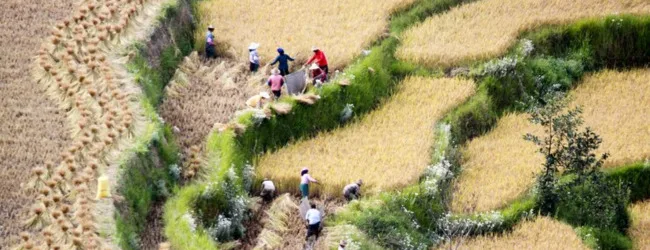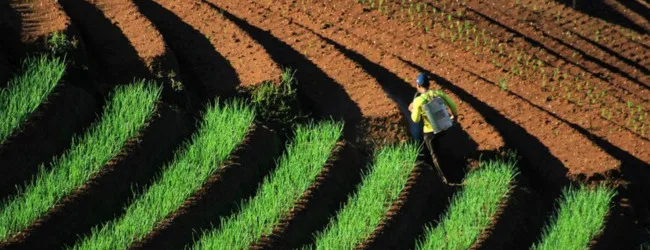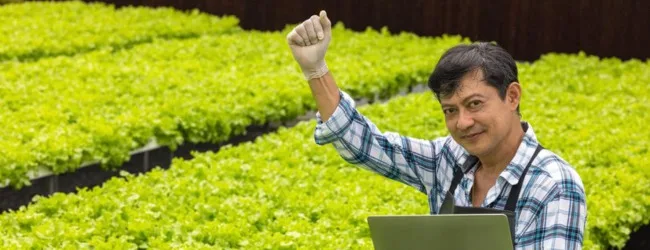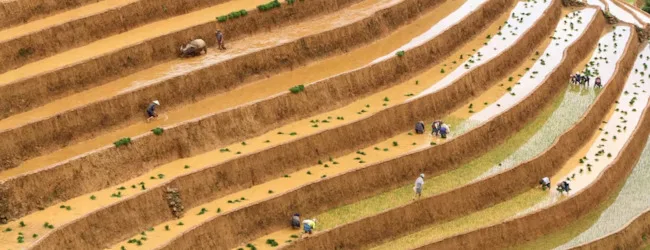Table of contents
- What is Step Farming?
- Why Choose Step Farming Business in India?
- Steps to Start a Step Farming Business in India
- 1. Comprehensive Research and Strategic Planning
- 2. Prudent Land Selection and Meticulous Preparation
- 3. Developing Essential Infrastructure
- 4. Strategic Crop Selection and Sustainable Cultivation
- 5. Navigating Legal and Regulatory Compliance
- 6. Effective Marketing and Sales Strategy
- Setup Cost and Other Investments
- Profit Margin in Step Farming
- Challenges and How to Overcome Them
- Conclusion
- Frequently Asked Questions (FAQs)
India’s diverse landscape offers unique agricultural opportunities. One such method, particularly suited for hilly and undulating terrains, is Step Farming, also widely known as terrace cultivation. This ancient technique is not just a farming method but a sustainable approach to land management. But how can you turn Step Farming into a viable business in India? This guide provides a comprehensive roadmap.
What is Step Farming?
Step Farming, or terrace cultivation, is an agricultural practice where sloped land is cut into a series of receding flat surfaces or platforms resembling steps.
- Purpose: The primary goal is to make hilly or mountainous terrain farmable.
- Mechanism: These “steps” or terraces reduce both erosion and surface runoff, crucial for conserving soil and water. Each level step catches rainwater, allowing it to soak into the soil rather than quickly running off, washing away topsoil and nutrients.
- Structure: Terraces can range from simple earthen banks (bunds) to elaborate stone retaining walls, depending on the slope, soil type, rainfall, and available resources.
Highlight: Step Farming transforms challenging slopes into productive agricultural land.
Why Choose Step Farming Business in India?

India, with its vast hilly regions like the Himalayas, Northeast states (like Nagaland, Mizoram), and the Western Ghats, presents significant potential for Step Farming. Here’s why it’s a compelling business choice:
- Maximizing Land Use: It makes cultivation possible on slopes that would otherwise be unsuitable for agriculture, effectively increasing arable land.
- Soil Conservation: This is one of its biggest advantages. By slowing down water runoff, step farming significantly reduces soil erosion, preserving fertile topsoil essential for healthy crops.
- Water Management: Terraces help retain rainwater, improving water absorption and availability for crops, which is crucial in areas with uneven rainfall. It can also reduce the risk of downstream flooding.
- Crop Diversity: A wide range of crops can be grown, including paddy rice (especially wet terraces), millets, maize, pulses, potatoes, vegetables (like cabbage, cauliflower, tomatoes), spices (cardamom, ginger, turmeric), fruits, and even tea or coffee in specific regions.
- Growing Market Demand: There’s an increasing demand for locally sourced, fresh produce, including speciality crops often grown in these unique terrains. Step farming can cater to niche markets, potentially fetching premium prices.
- Ecological Benefits: It’s an environmentally sound practice that contributes to biodiversity and maintains the ecological balance in fragile hilly ecosystems.
Steps to Start a Step Farming Business in India

Embarking on a Step Farming venture requires meticulous planning and execution. Here’s a more detailed breakdown of the essential steps tailored for the Indian context:
1. Comprehensive Research and Strategic Planning
This foundational stage sets the direction for your entire business.
In-depth Market Analysis:
- Identify Target Crops: Don’t just pick crops randomly. Research which crops thrive in your specific agro-climatic zone and have strong, stable market demand. Consider staples (rice, maize, millets), vegetables (potatoes, onions, tomatoes, leafy greens), high-value spices (ginger, turmeric, cardamom), fruits (suitable for temperate or subtropical hills), or niche products (medicinal herbs, aromatic plants, organic produce).
- Analyze Market Dynamics: Visit local mandis (agricultural markets), talk to wholesalers, retailers, and even consumers. Understand price fluctuations, seasonal demand, quality preferences, and existing competition. Explore potential buyers like hotels, restaurants, organic stores, or export markets.
- Competitor Check: Identify other farmers (step farming or otherwise) growing similar crops in your region. Analyze their scale, practices, and market channels.
- Thorough Feasibility Study:
- Agro-Climatic Suitability: Confirm your chosen crops match the local rainfall patterns, temperature ranges, and sunlight availability.
- Soil Health Assessment: Conduct detailed soil testing. Understand its type (sandy, loamy, clayey), pH, nutrient content (Nitrogen, Phosphorus, Potassium – NPK, micronutrients), and depth. This is crucial for terrace stability and crop choice.
- Water Resource Evaluation: Assess the reliability and quality of water sources (rainfall, streams, springs, groundwater). Determine if existing sources are sufficient or if investment in water harvesting/storage (like check dams or farm ponds) is needed.
- Logistical Assessment: Evaluate road access to the site for transporting inputs (fertilizers, machinery) and outputs (harvested produce). Poor connectivity increases costs and risks spoilage.
- Developing a Robust Business Plan:
- Executive Summary: A brief overview of your business concept.
- Farm Description: Location, size, land details, vision, mission, and objectives.
- Market Analysis Summary: Findings from your market research.
- Operations Plan: Detailed plan for terrace design and construction (type of terraces, materials), cropping patterns, farming techniques (conventional/organic), irrigation and drainage plan, labour requirements, and equipment list.
- Management Team: Your background and any team members involved.
- Financial Projections: This is critical. Include detailed startup costs (land, construction, irrigation, initial inputs, registration), recurring operational costs (labour, seeds, fertilizers, maintenance, marketing), projected yields and revenue based on realistic market prices, break-even analysis, and profitability forecast for at least 3-5 years.
- Funding Strategy: Outline how you plan to finance the venture (personal savings, bank loans like Kisan Credit Card – KCC, NABARD schemes, government subsidies).
- Contingency Planning: Identify potential risks (weather, pests, market crash) and outline mitigation strategies.
2. Prudent Land Selection and Meticulous Preparation
The land is your primary asset.
Land Acquisition Strategy:
- Options: Evaluate owning versus leasing land. Leasing reduces initial capital but offers less long-term security. Ancestral land can be an option but ensure clear title and family consensus.
- Due Diligence: Verify land titles and records meticulously. In Karnataka, check RTC/Pahani; other states have equivalent documents. Ensure the land is zoned for agricultural use and free from legal disputes.
- Detailed Site Assessment:
- Topography Mapping: Accurately measure slope angles (using a clinometer or survey equipment) across the entire area. This dictates terrace design.
- Soil Profiling: Examine soil depth and layers. Deep, stable soil is ideal for constructing durable terraces. Avoid areas prone to landslides.
- Aspect Consideration: Note the direction the slope faces (north, south, east, west). This affects sunlight exposure and temperature, influencing crop choice and planting times.
- Terrace Design and Construction:(This is often the most complex and expensive phase)
- Choosing Terrace Type: Select based on slope gradient: Bench terraces (for steeper slopes, most common), contour bunds (gentler slopes, earthen embankments), or graded terraces (slight channel gradient for drainage).
- Engineering/Expert Guidance: Highly Recommended to consult agricultural engineers or experienced local practitioners for designing stable, effective terraces suited to your specific site conditions. Poor design can lead to collapse and erosion.
- Construction Process: Involves marking contours, excavation (‘cut and fill’ method), leveling the benches, compacting the soil thoroughly, and constructing retaining walls if necessary (using locally sourced stone, concrete blocks, or gabion structures). Ensure a slight inward slope on benches for water retention and stability.
- Labour vs. Machinery: Assess the cost-benefit of using manual labour versus machinery (like excavators/JCBs), considering terrain accessibility, soil type, and budget.
3. Developing Essential Infrastructure

Supporting systems are vital for efficiency.
Efficient Irrigation System:
- System Selection: Drip irrigation is highly recommended for water efficiency in step farming. Design the layout considering terrace structure and crop water needs. Sprinklers or gravity-fed channels are other options.
- Water Source Development: If needed, invest in borewells (check groundwater regulations), rainwater harvesting structures (ponds, tanks), or small check dams on streams (subject to permissions).
- Water Management Plan: Estimate crop water requirements and plan irrigation schedules.
- Effective Drainage Network:
- Preventing Waterlogging: Design drainage channels or outlets at the edges of terraces to safely remove excess rainwater during monsoons, preventing waterlogging and potential terrace damage. Ensure outlets don’t cause erosion downslope.
💡 Pro Tip: If you want to start a farming business but have too many doubts, connect with a farming business expert from Boss Wallah for guidance – https://bw1.in/1116
4. Strategic Crop Selection and Sustainable Cultivation
The core farming operations.
Informed Crop Choice:
- Matching Climate and Soil: Select crops proven to grow well in your specific micro-climate and soil type (referencing state agricultural university recommendations).
- Rotation and Intercropping: Plan crop rotation cycles to maintain soil health and reduce pest build-up. Consider intercropping compatible species for better land utilization and biodiversity.
- Economic Viability: Prioritize crops with good market value and consistent demand, balancing yield potential with input costs.
- Quality Input Sourcing:
- Seeds/Saplings: Purchase certified seeds or healthy saplings from government agencies (like State Dept. of Horticulture/Agriculture), agricultural universities, KVKs, or reputable private nurseries.
- Nutrient Management: Based on soil tests, plan your fertilizer strategy. Emphasize organic inputs like Farm Yard Manure (FYM), vermicompost, compost, and bio-fertilizers to improve soil structure and health long-term. Use chemical fertilizers judiciously as per recommendations (Integrated Nutrient Management – INM).
- Adopting Good Agricultural Practices (GAP):
- Land Preparation: Proper tilling and leveling of terraces before planting.
- Planting Techniques: Optimal spacing, sowing depth, and planting time.
- Integrated Pest & Disease Management (IPM): Focus on prevention, monitoring, and using biological controls or biopesticides before resorting to chemical options.
- Weed Management: Timely manual weeding or use of mulching.
- Harvesting & Post-Harvest: Harvest crops at the right maturity. Implement proper cleaning, grading, storage, and packaging to maintain quality and reduce losses.
5. Navigating Legal and Regulatory Compliance
Operating within the legal framework.
- Business Structure & Registration: Choose a structure (Sole Proprietorship, Partnership, Farmer Producer Organisation/Company – FPO/FPC, Private Ltd. Co.) and register accordingly with local authorities (e.g., Udyam Registration for MSMEs).
- Securing Necessary Licenses & Permits:
- Land Use: Ensure compliance with local land use regulations.
- Water: Permits may be needed for extracting groundwater or constructing dams.
- Market Access: Mandi license if selling directly in regulated markets.
- Food Processing/Sales: FSSAI registration/license if involved in processing or packaged food sales.
- Organic Certification: If targeting the organic market, undergo the certification process through accredited agencies.
- GST Registration: Required if your annual turnover exceeds the government-prescribed threshold.
- Ongoing Compliance: Adhere to labour laws (Minimum Wages Act, etc.), environmental regulations regarding waste disposal and pesticide use, and any state-specific agricultural laws.
6. Effective Marketing and Sales Strategy

Connecting your produce with buyers.
Developing Market Linkages:
- Direct Sales: Farm gate sales, local farmers’ markets, Community Supported Agriculture (CSA) models, direct supply to local restaurants/hotels/housing societies.
- Indirect Sales: Selling through aggregators, wholesalers in local mandis, or joining an FPO for collective marketing and better price negotiation.
- Online Platforms: Utilize B2B or B2C agri-tech platforms to reach a wider customer base (requires robust logistics).
- Contract Farming: Secure agreements with food processing companies or retailers for assured off-take (ensure fair terms).
- Value Proposition & Branding:
- Quality Focus: Emphasize freshness, quality, and sustainable practices (especially if organic).
- Storytelling: Highlight the origin of your produce (grown on Himalayan/Western Ghats terraces, etc.) and the sustainable methods used.
- Packaging: Use appropriate and attractive packaging, especially for direct sales.
Building Relationships: Network actively with potential buyers, participate in agricultural fairs/expos, and build a reputation for reliability and quality.
ALSO READ | How to Start Goat Farming Business in India: A Complete Guide
Setup Cost and Other Investments
Starting a Step Farming business involves considerable investment, especially in the initial phase. Costs can vary significantly based on location, scale, land condition, and chosen technology.
- Land Cost: Purchase or lease costs (highly variable).
- Terrace Construction: This is often the largest initial expense. Costs depend on the slope’s steepness, soil type, machinery vs. manual labour, and whether retaining walls are needed. Costs can range from thousands to lakhs of rupees per unit area.
- Irrigation System: Varies based on type (drip systems can range from ₹40,000 – ₹70,000 per acre, but costs fluctuate).
- Inputs: Seeds, saplings, fertilizers, pest control measures (costs depend on crop and area).
- Labour: Significant cost, especially for construction and ongoing farm operations.
- Tools & Equipment: Basic tools, possibly small machinery.
- Marketing & Distribution: Costs for packaging, transport, promotional activities.
- Contingency Fund: Essential for unforeseen expenses (approx. 10-15% of total budget).
Note: Seek estimates from local contractors and agricultural suppliers for accurate budgeting. Explore potential government subsidies.
Profit Margin in Step Farming
Profitability in Step Farming depends heavily on several factors:
- Crop Choice: High-value crops (spices, speciality vegetables, medicinal herbs) generally yield higher returns than staple crops.
- Yield: Depends on soil fertility, crop management practices, weather conditions, and irrigation.
- Market Price: Fluctuates based on demand, supply, and quality. Direct selling or targeting niche markets can improve prices.
- Operational Efficiency: Managing costs (labour, inputs, irrigation) effectively is crucial.
- Scale of Operation: Larger farms may benefit from economies of scale but also require higher investment.
While the initial investment is high, well-managed Step Farming businesses focusing on market-demanded crops can achieve good profitability and ROI over the medium to long term, especially considering the sustainable nature of the practice. It’s crucial to have realistic financial projections in your business plan.
ALSO READ | 5 Tips for ultimate mango farming in India
Challenges and How to Overcome Them

High Initial Investment: Terrace construction is expensive.
- Solution: Phase the development, start small, seek government subsidies or loans (like those under NABARD schemes or state agriculture departments), and explore cost-effective construction techniques.
Labour Intensive: Construction and farming operations require significant manual effort.
- Solution: Utilize appropriate small machinery where feasible, involve community participation, or join FPOs for shared resources.
Water Management: Ensuring adequate water, especially during dry spells, can be difficult.
- Solution: Invest in efficient irrigation (drip), implement rainwater harvesting, and select drought-tolerant crops where appropriate.
Accessibility: Remote hilly areas often have poor road connectivity, impacting transportation of inputs and produce.
- Solution: Factor logistics into your planning, explore collective transport options through FPOs, or focus on local markets.
Technical Expertise: Designing and constructing stable terraces requires knowledge.
- Solution: Consult agricultural engineers or experienced local farmers, attend training programs offered by agricultural universities or KVKs (Krishi Vigyan Kendras).
Need Expert Guidance?
Starting a business can be challenging, but you don’t have to do it alone! At Boss Wallah, our 2,000+ business experts are ready to provide valuable insights and guidance. Whether you need help with marketing, finance, sourcing, or any other area of any business, our business experts are here to help you succeed- https://bw1.in/1116
Confused about Which Business to Start?
Want to start your own business but unsure which one to choose? Explore Boss Wallah, where you’ll find 500+ courses by successful business owners, featuring practical, step-by-step guides on starting and growing various businesses.
Find your perfect business idea today – https://bw1.in/1111
Conclusion
Step Farming is more than just a method to cultivate slopes; it’s a sustainable agricultural system vital for India’s hilly regions. Starting a Step Farming business requires substantial effort and investment, but the potential rewards – financial, environmental, and social – are significant. With careful planning, sound agricultural practices, effective market linkages, and perseverance, a Step Farming venture in India can be a successful and impactful enterprise, contributing to food security and ecological preservation.
Frequently Asked Questions (FAQs)
1. Is Step Farming the same as Terrace Farming? Yes, Step Farming and Terrace Farming (or terrace cultivation) are terms used interchangeably to describe the practice of creating step-like flat surfaces on slopes for cultivation.
2. What are the best crops for Step Farming in India? Suitable crops vary by region and climate but often include paddy rice (especially in wet terraces), maize, millets, wheat, barley, potatoes, ginger, turmeric, cardamom, various vegetables (cabbage, cauliflower, beans), pulses, and fruits. High-value medicinal or aromatic plants can also be profitable.
3. Is Step Farming expensive to start? Yes, the initial cost, particularly for terrace construction, can be high compared to farming on flat land. However, government subsidies and long-term benefits like soil conservation can offset this.
4. Does the Indian government provide support for Step Farming? Yes, various central and state government schemes related to watershed management, soil conservation, horticulture development (like MIDH – Mission for Integrated Development of Horticulture), and schemes under NABARD often support terrace construction and agriculture in hilly areas. Check with your local agriculture department or KVK for specific schemes.
5. How does Step Farming help the environment? It significantly reduces soil erosion caused by water runoff on slopes, conserves water by increasing infiltration, helps maintain slope stability, and supports biodiversity in hilly ecosystems.
6. Can Step Farming be done organically? Absolutely. Step farming is well-suited for organic practices. The controlled environment of terraces can make managing soil fertility with organic inputs and implementing non-chemical pest control easier.
7. What is the minimum land required to start a Step Farming business? There’s no strict minimum, but commercial viability depends on the crop, market, and operational efficiency. Even small plots can be productive, but larger areas might be needed for significant income generation. A detailed business plan will help determine the required scale.
8. Are there any major risks involved in Step Farming? Besides the financial investment, risks include landslides (if terraces are poorly constructed), water scarcity, pest/disease outbreaks, market price volatility, and transportation challenges in remote areas. Proper planning and management can mitigate many of these risks.


